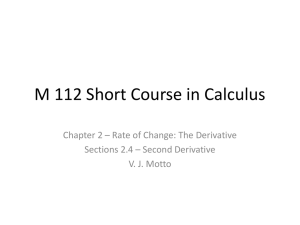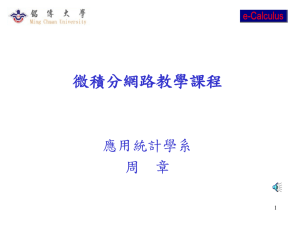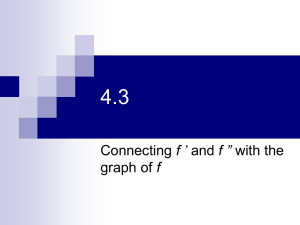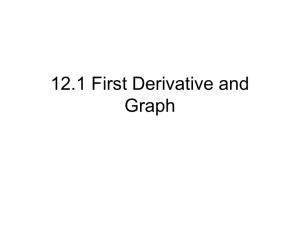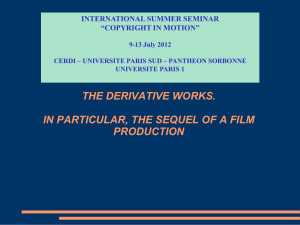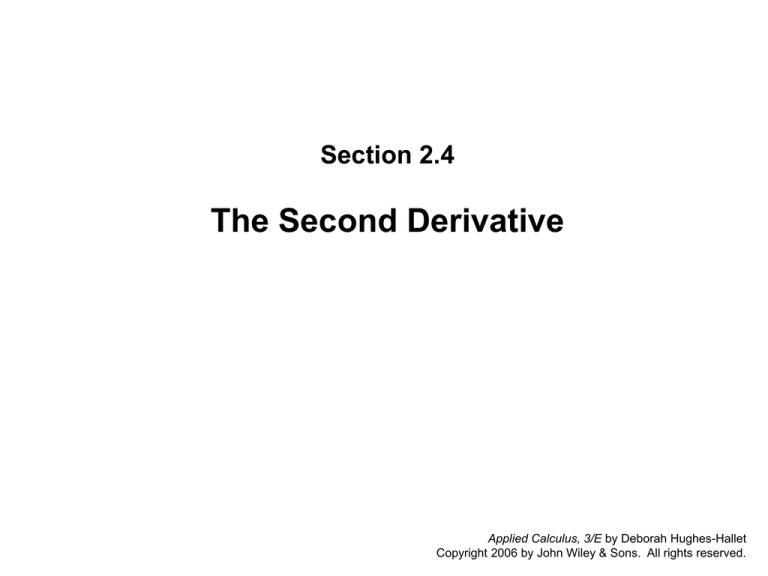
Section 2.4
The Second Derivative
Applied Calculus, 3/E by Deborah Hughes-Hallet
Copyright 2006 by John Wiley & Sons. All rights reserved.
The First Derivative
•
•
If the first derivative is positive on an interval, the function is increasing on that interval
If the first derivative is negative on an interval, the function is decreasing on that interval
Applied Calculus, 3/E by Deborah Hughes-Hallet
Copyright 2006 by John Wiley & Sons. All rights reserved.
The First Derivative
Recall
Applied Calculus, 3/E by Deborah Hughes-Hallet
Copyright 2006 by John Wiley & Sons. All rights reserved.
Describe each graph’s direction and concavity …
I
II
III
IV
I. Increasing and concave up - Increasing at an increasing rate
II. Decreasing and concave up - Decreasing at an increasing rate
(decreasing magnitude)
III.Increasing and concave down - Increasing at a decreasing rate
IV.Decreasing and concave down - Decreasing at a decreasing rate
(increasing magnitude)
The Second Derivative
•
•
The second derivative is the derivative of the derivative function.
Thus the second derivative tells us something about the rate of change of the derivative.
•
If the first derivative is increasing on an interval, then the function is concave up on that interval.
And, if the first derivative is increasing on an interval, the second derivative is positive on that
interval.
•
If the first derivative is decreasing on an interval, then the function is concave down on that
interval. And, if the first derivative is decreasing on an interval, the second derivative is negative
on that interval.
•
An inflection point is a point at which the concavity changes.
The Second Derivative
Applied Calculus, 3/E by Deborah Hughes-Hallet
Copyright 2006 by John Wiley & Sons. All rights reserved.
Example
Applied Calculus, 3/E by Deborah Hughes-Hallet
Copyright 2006 by John Wiley & Sons. All rights reserved.
The Second Derivative: Meaning
Practical Meaning: The second derivative gives us information about whether the rate
is increasing or decreasing.
• Distance, Velocity, Acceleration
• Price of a stock
• Rate of spending
The Second Derivative: Meaning
Example:
The price of a stock is rising faster and faster.
Example:
The price of a stock is close to bottoming out.
The Second Derivative: Meaning
Example:
An industry is being charged by the Environmental Protection Agency (EPA) with
dumping unacceptable levels of toxic pollutants in a lake. Measurements are made of
the rate at which pollutants are being discharged into the lake. What does the
following graph mean and how would the industry and the EPA interpret the graph.
Rate of discharge
The EPA will say that the
rate of discharge is still
rising. The industry will
say that the rate of
discharge is increasing
less quickly, and may soon
level off or even start to fall.
A year ago
Now
The Second Derivative: Meaning
Rate of discharge
Example:
An industry is being charged by the Environmental Protection Agency (EPA) with
dumping unacceptable levels of toxic pollutants in a lake. Measurements are made of
the rate at which pollutants are being discharged into the lake. What does the
following graph mean and how would the industry and the EPA interpret the graph.
A year ago
Now
The EPA will say that the
rate at which pollutants
are being discharged is
leveling off, but not to
zero—so pollutants
will continue to be
dumped in the lake. The
industry will say that the
rate of discharge has
decreased significantly.
Which is f, f’, and f’’?
No pair of graphs are 𝑓 and 𝑓′.
So, if 𝑓 is the red graph, sketch
graphs of 𝑓′ and 𝑓′′.
High School Example
A high school principal is concerned about the drop in the percentage of students who
graduate from her school, shown in the following table.
Year entered school,
Percent graduating,
1992
62.8
1995
54.1
1998
48.0
2001
43.5
2004
41.8
1. Calculate the average rate of change of 𝑃 for each of the three-year intervals between
1992 and 2004.
Interval,
Ave. Rate of Change,
92→95
-2.9
95→98
-2.0
98→01
-1.5
01→04
-0.6
2. Does 𝑑2 𝑃/𝑑𝑡 2 appear to be positive or negative between 1992 and 2004?
3. Explain why the values of 𝑃 and 𝑑𝑃/𝑑𝑡 are troublesome to the principal.
4. Explain why the sign of 𝑑2 𝑃/𝑑𝑡 2 and the magnitude of 𝑑𝑃/𝑑𝑡 in the year 2001 may
give the principal some cause for optimism.

